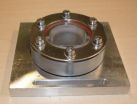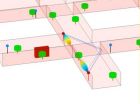(Press-News.org) WASHINGTON, June 9—Monitoring a patient's vital signs and other physiological parameters is a standard part of medical care, but, increasingly, health and fitness-minded individuals are looking for ways to easily keep their own tabs on these measurements. Enter the biometric watch.
In a pair of papers published in The Optical Society's (OSA) open-access journal Biomedical Optics Express, groups of researchers from the Netherlands and Israel describe two new wearable devices that use changing patterns of scattered light to monitor biometrics: one tracks glucose concentration and dehydration levels, and the other monitors pulse.
The glucose sensor is the first wearable device that can measure glucose concentration directly but noninvasively, the authors say.
And while other wearable devices have been made to monitor pulse, the authors claim their new design would be less sensitive to errors when the wearer is in motion, for example while walking or playing sports
Both of the watches described in the two papers make use of the so-called "speckle" effect, the grainy interference patterns that are produced on images when laser light reflects from an uneven surface or scatters from an opaque material. When the material that is scattering the light is moving—say, in the case of blood flowing through the circulatory system—"the speckle pattern changes with changes in the flow," explained biomedical engineer Mahsa Nemati, a graduate student in the Optics Research Group at the Delft University of Technology in the Netherlands and the lead author of the Biomedical Optics Express paper on monitoring pulse. Those light variations are a valuable source of information, she says.
The 'Holy Grail' of Diagnostics
In the first paper, bioengineer Zeev Zalevsky of Israel's Bar-Ilan University and his colleagues describe a new wearable biometric system that uses the speckle effect to directly monitor the glucose concentration in the bloodstream, as well as the wearer's relative hydration level.
"Glucose is the holy grail of the world of biomedical diagnostics, and dehydration is a very useful parameter in the field of wellness, which is one of our main commercial aims," Zalevsky said.
The watch-like device consists of a laser to generate a wavefront of light that illuminates a patch of skin on the wrist near an artery, and a camera that measures changes over time in the light that is backscattered off the skin. Unlike other chemicals present in the blood, glucose exhibits a so-called Faraday effect. This means that in the presence of an external magnetic field (generated by a magnet attached to the device) the glucose molecule alters the polarization of the wavefront and thus influences the resulting speckle patterns. Analyzing these changing patterns provides a direct measurement of the glucose concentration. Because one of the main signs of mild to moderate dehydration is muscle weakness, which will alter the strength of the signals, the same device can also be used to indicate the relative dehydration level of the user as it changes over time.
Zalevsky and his colleagues are now working to reduce the margin of error in the device's readings. "Around 96 percent of our in vivo measurements were within a range of 15 percent deviation from the readout of a medical reference glucometer device," Zalevsky noted. "The main factor for errors now is the stability of our device on the wrist of the user. We are currently investing efforts in deriving proper calibration and motion cancellation procedures that will allow us to reduce this sensitivity."
Zalevsky says this is the first step toward non-invasive, continuous in vivo measurement of glucose that is based on sensing an effect that is directly related to glucose concentration. The team expects a commercial version of the device to reach the market within two to three years.
Pulse Tracker
In the second Biomedical Optics Express paper, published today, Nemati and her colleagues at Delft and at Phillips Research developed a method that could be used to monitor pulse non-invasively with a sensor that isn't thrown off by the wearer's movement.
Using simulated heart beats generated in milk and measurements performed on the finger of a volunteer, they found that speckle changes can be used to accurately measure flow pulsations—that is, the heart rate—even when the light source used to create the speckle pattern is also moving, as would be the case with a wearable biometric sensor. The researchers found that just a couple of pixels from the image were sufficient to extract the pulse rate.
"This paper shows for the first time that a speckle pattern generated from a flowing liquid can give us the pulsation properties of the flow in spite of motion-induced artifacts," Nemati said. "Sophisticated optics is not necessary to implement this, so the costs for devices can be kept low. Another advantage is that the devices can be non-contact or far from the sample," she added.
The team is currently working with companies to integrate their motion-friendly pulse-monitoring technique into existing sensors, for potential use clinically as well as in sports, Nemati said.
INFORMATION:
Papers:
"Improved noncontact optical sensor for detection of glucose concentration and indication of dehydration level," N. Ozana et al., Biomedical Optics Express, Vol. 5, Issue 6, pp. 1926-1940 (2014). http://www.opticsinfobase.org/boe/abstract.cfm?uri=boe-5-6-1926
"Dynamic light scattering from pulsatile flow in the presence of induced motion artifacts," M. Nemati et al., Biomedical Optics Express, vol. 5, Issue 7, pp. 2145-2156 (2014). http://www.opticsinfobase.org/boe/abstract.cfm?uri=boe-5-7-2145
EDITOR'S NOTE: Images are available to members of the media upon request. Contact Angela Stark, astark@osa.org.
About Biomedical Optics Express
Biomedical Optics Express is OSA's principal outlet for serving the biomedical optics community with rapid, open-access, peer-reviewed papers related to optics, photonics and imaging in the life sciences. The journal scope encompasses theoretical modeling and simulations, technology development, and biomedical studies and clinical applications. It is published by The Optical Society and edited by Joseph A. Izatt of Duke University. Biomedical Optics Express is an open-access journal and is available at no cost to readers online at http://www.OpticsInfoBase.org/BOE.
About OSA
Founded in 1916, The Optical Society (OSA) is the leading professional society for scientists, engineers, students and business leaders who fuel discoveries, shape real-world applications and accelerate achievements in the science of light. Through world-renowned publications, meetings and membership programs, OSA provides quality research, inspired interactions and dedicated resources for its extensive global network of professionals in optics and photonics. For more information, visit http://www.osa.org.
New biometric watches use light to non-invasively monitor glucose, dehydration, pulse
2014-06-10
ELSE PRESS RELEASES FROM THIS DATE:
A life well spent: Consume now (in case you die early)
2014-06-10
PRINCETON, N.J.—You only live once. Carpe diem. You can't take it with you.
As often as we hear these clichés, they might include some real economic wisdom for some, according to research led by Princeton University's Woodrow Wilson School. The researchers argue in the Journal of Mathematical Economics that some people might want to spend more and work less – just in case their time runs out.
Marc Fleurbaey, the Robert E. Kuenne Professor in Economics and Humanistic Studies and professor of public affairs, and his collaborators – Marie-Louise Leroux from the University ...
Innovative millimeter wave communications to be demonstrated at London exhibition
2014-06-10
Wireless data connections that exploit millimetre wave radio spectrum (30GHz to 300GHz) are expected to be used in worldwide 5G networks from 2020. The University of Bristol's Communication Systems and Networks research group has partnered with Bristol start-up Blu Wireless Technology (BWT) to develop this technology and they will demonstrate their innovative work at the Small Cells World Summit in London this week [10-12 June].
Millimetre wave radios use much higher carrier frequencies than those in current systems, such as 4G and Wi-Fi. The University and BWT radios ...
CU Denver study finds serious challenges to 'New Urbanist' communities
2014-06-10
DENVER (June 10, 2014) – As New Urbanist communities expand nationwide, a study from the University of Colorado Denver shows the increasing challenges of balancing complex traffic engineering systems with the ideals of walkable, sustainable neighborhoods.
As a leading public research university located in the urban core, CU Denver researchers have ample opportunity to connect their work to the city of Denver and surrounding communities. This study focused on Denver's Stapleton neighborhood, one of the largest New Urbanist developments in the nation, specifically examining ...
UK science trio called to Washington ocean summit
2014-06-10
Three leading environmental scientists from the UK have been invited to talk about the state of the world's oceans to an audience including US Secretary of State John Kerry at an ocean summit in Washington. They are amongst less than thirty scientists from around the world who will be providing hard–hitting messages about the need for closer cooperation to overcome the challenges facing our oceans.
Their invitation to this important event is a testament to the excellence of UK environmental science, and underlines its vital role in tackling some of the key challenges ...
Calls to end all violence against women and girls in conflict zones
2014-06-10
AUDIO:
Mazeda Hossain, Lecturer in Social Epidemiology at the London School of Hygiene & Tropical Medicine, talks about her research into violence and health in conflict-affected settings.
Click here for more information.
Women in conflict zones are likely to suffer from sexual or physical violence at the hands of their husbands or partners before, during and after a period of conflict, warn experts from the London School of Hygiene & Tropical Medicine as politicians, activists ...
Compact proton therapy for fight against cancer
2014-06-10
The future face of modern-day anti-cancer therapy based on charged particles like protons could potentially involve using laser accelerators. However, these facilities will need to be reduced in terms of both size and cost compared to conventional ones. In the scientific journal, Applied Physics B, Dresden medical physicist Umar Masood is the first to present a new design for the entire complex machine – from the accelerator to the radiation site. In the process, he has successfully cut the facility's size in half.
In the fight against cancer, proton therapy is especially ...
Sopcawind, a multidisciplinary tool for designing wind farms
2014-06-10
This news release is available in Spanish. The development of a wind farm is a process in which various factors need to be taken into consideration to ensure that the resource is properly used and that appropriate planning is carried out to minimise the effects it could have. "The fundamental parameter to take into account when designing a wind farm is the wind or wind potential. Another very important factor is the orography of the land," explained David de la Vega, a member of the Signal Processing and Radiocommunications Group (TSR). "Apart from these two main factors, ...
Penn research develops 'onion' vesicles for drug delivery
2014-06-10
One of the defining features of cells is their membranes. Each cell's repository of DNA and protein-making machinery must be kept stable and secure from invaders and toxins. Scientists have attempted to replicate these properties, but, despite decades of research, even the most basic membrane structures, known as vesicles, still face many problems when made in the lab. They are difficult to make at consistent sizes and lack the stability of their biological counterparts.
Now, University of Pennsylvania researchers have shown that a certain kind of dendrimer, a molecule ...
NYU Langone internist calls for VA system reform
2014-06-10
An NYU Langone internal medicine specialist who served as a White House fellow at the US Department of Veteran's Affairs says the headline-grabbing failures of the VA health system's administration stand in sharp contrast to the highly rated care the system delivers.
In an editorial in The New England Journal of Medicine online June 5, Dave Chokshi, MD, MS, an assistant professor at NYU Langone Medical Center, says the paradox has created a watershed moment to reform and refocus the way the entire system is structured, staffed, and managed, while also building on its ...
Obstetric malpractice claims dip when hospitals stress patient safety
2014-06-10
A Connecticut hospital saw a 50% drop in malpractice liability claims and payments when it made patient safety initiatives a priority by training doctors and nurses to improve teamwork and communication, hiring a patient safety nurse, and standardizing practices, according to a study by Yale School of Medicine researchers.
The results, published in the June 9 online issue of the American Journal of Obstetrics and Gynecology, come at a time when mounting concerns about liability are thinning the ranks of obstetricians in the United States, according first author Christian ...







